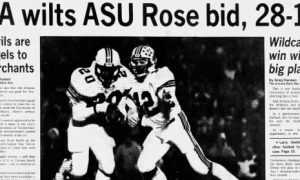
EDITOR’S NOTE: Due to the controversy surrounding Sean Miller’s technical foul in last year’s Pac-12 Tournament, an event in which former Pac-12 director of officiating Ed Rush reportedly placed a bounty on Miller to be thrown out or given a technical, this site will monitor the league’s officials during the course of the season through the conference tournament in March. The integrity of the game and its officiating was called into question by Rush’s actions, which ultimately led to his resignation.
Past the halfway mark of the Pac-12 season we have a sense of which teams are getting the most calls usually because of their aggressive play in the lane rather than only on the perimeter.
Without point guard Spencer Dinwiddie, Colorado’s NCAA tournament hopes literally live on the free-throw line. The Buffaloes lead the Pac-12 in free-throw-attempt differential (an unbelievable plus-114) and personal-foul calls (plus-44).
In Colorado’s 68-63 win over perimeter-oriented Washington State last night, the host Buffaloes took 15 more free-throw attempts than the Cougars because they were called for a foul nine fewer times. Colorado outscored Washington State 18-8 at the stripe.
In Colorado’s regular-season sweep of Washington State this season, the Buffaloes were 44-of-65 from the free-throw line compared to Washington State’s 11-of-15 performance. That is fifty more free throw attempts in two games. In each game, remarkably, Washington State had 22 fouls compared to Colorado’s 13.
Arizona, known for taking a limited amount of three-pointers because it attacks the lane, is second behind Colorado with a plus-64 mark in free throw attempts. The Wildcats are tied with Oregon State at fourth with plus-24 fouls called.
The Wildcats’ opponent tonight at McKale, Oregon, is more guard-oriented this year, especially without former center Arsalan Kazemi, who is playing pro ball is in his native Iran. The Ducks are last in the Pac-12 with a minus-35 mark in personal fouls and 10th with a minus-39 differential in free-throw attempts.
The question is … if Arizona gets a majority of the calls, which is likely to happen, can the Wildcats be efficient at the free-throw line like they were at Cal?
Michael Irving Watch: The official who gave Sean Miller a technical foul in last year’s Pac-12 tournament has yet to officiate an Arizona game. He has officiated three Washington games.
Welcome: The Pac-12 introduced four more officials last week to increase the number to 49 utilized in conference games this season.
Rivalry ref: Frank Harvey’s first two games of the season calling Pac-12 games involved rivalry games. The 17-year ref called the Washington-Washington State game Saturday and the Stanford-Cal game last night.
Whistle-happy: In five games, veteran ref Bob Staffen leads all Pac-12 officials with an average of 42.8 personal fouls and 54.4 free-throw attempts (including his crews).
Swallowed whistle: Kevin Brill’s crews have called league-low averages of only 30.2 fouls and 26.6 free-throw attempts in five games.
Biggest homer?: David Hall and his crews continue to have this distinction with home teams getting 34 more calls and 51 more free-throw attempts than visitors in the seven games he’s officiated.
Thick-skinned: The anti-David Hall is Michael Scyphers, who with his crews has called 21 fewer fouls on visiting teams in six games. Scyphers officiated Arizona’s upset loss at Cal Saturday. The Golden Bears were whistled for three more fouls (16-13) and Arizona attempted eight more free throws (the Wildcats were 16-of-16 and Cal was 6-of-8).
Most used: Randy McCall has officiated 10 games and Verne Harris has called nine.
Least used: Twelve of the 49 referees used to this point have called only one game.
The following five charts involved a few hours of my time putting together data of league referees. I will update the data through the season. Here is a brief description of each:
Chart 1 and 2: Chart 1 indicates the referees who have officiated at least three Pac-12 games in the first four weeks of the season. Chart 2 lists all officials.
Within Chart 2, it first lists the years the referees have worked college basketball games per statsheet.com.
The conference record shown indicates the cumulative combined conference records of the teams at the time they played in the game called by the ref.
The “Rank” column is the number of games called that involve AP Top 25 teams. Also listed are stats related to games called by a referee’s crew: Personal fouls, average of personal fouls, disqualifications, technical fouls, free-throw attempts and free-throw attempt average a game.
Other columns: PFDiff — Difference between fouls of home and away teams (a minus score reflects more calls made for the visitor), and FTDiff — Difference between free-throw attempts of home and away teams (again, a minus score reflects more calls made for the visitor).
Chart 3 and 4: Chart 3 indicates the number of overall games called by a ref of a particular conference team. Chart 4 has the same principle but indicates only certain locations where the referee called a game.
Chart 5: Indicates difference of calls made for a team at home compared to on the road in Pac-12 games. HPFDIFF stands for “Home Personal Foul Difference” compared calls to visitors. HFTDIFF stands for “Home Free Throw (attempts) compared to visitors. The same principle applies for when on the road for APFDIFF and AFTDIFF. The total of each category is signified with TotPFD and TotFTD.
CHART ONE: MOST-USED OFFICIALS
[csv src=http://wildaboutazcats.net/wp-content/uploads/2014/02/Pac12RefsMostGames91.csv]
CHART TWO: ALL OFFICIALS
[csv src=http://wildaboutazcats.net/wp-content/uploads/2014/02/Pac12RefsOverall91.csv]
CHART THREE: REFS BY TEAMS CALLED
[csv src=http://wildaboutazcats.net/wp-content/uploads/2014/02/Pac12RefsAllGames9.csv]
CHART FOUR: REFS BY LOCATIONS CALLED
[csv src=http://wildaboutazcats.net/wp-content/uploads/2014/02/Pac12RefsRoadGames9.csv]
CHART FIVE: DIFFERENCE OF CALLS HOME AND AWAY
[csv src=http://wildaboutazcats.net/wp-content/uploads/2014/02/HomeAway91.csv]
WILDABOUTAZCATS.net publisher, writer and editor Javier Morales is a former Arizona Press Club award winner. He also writes articles for Bleacher Report, Lindy’s College Sports and TucsonCitizen.com.
[rps-paypal]
|
|






















